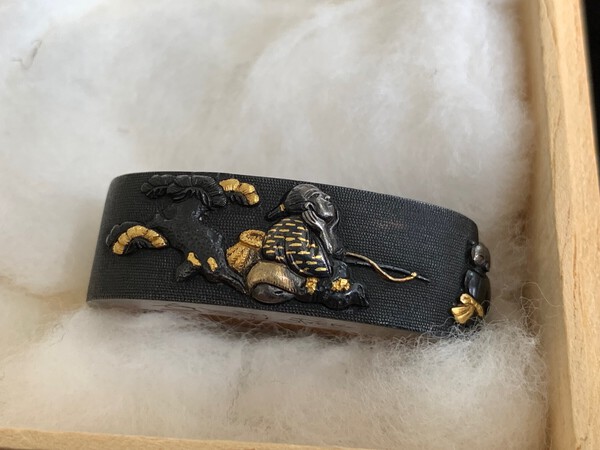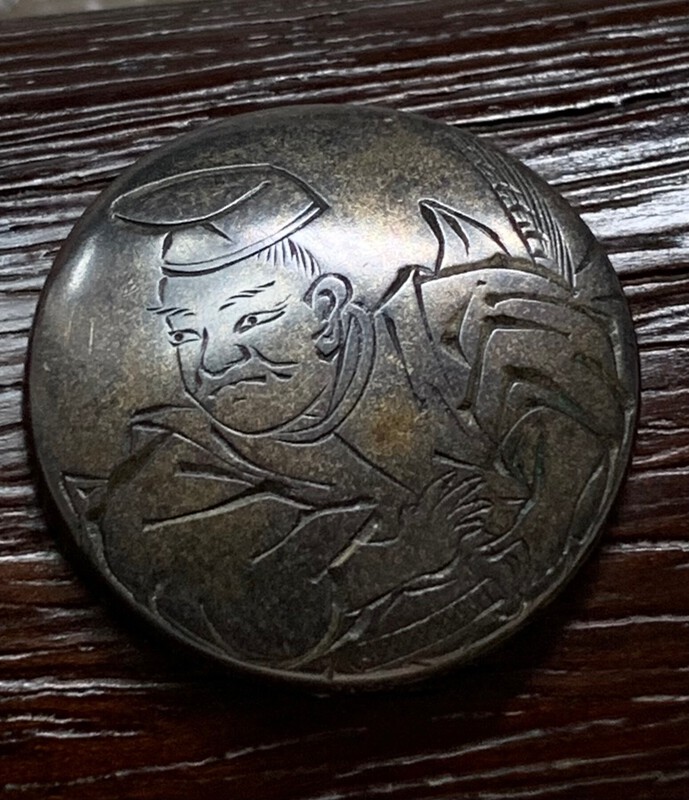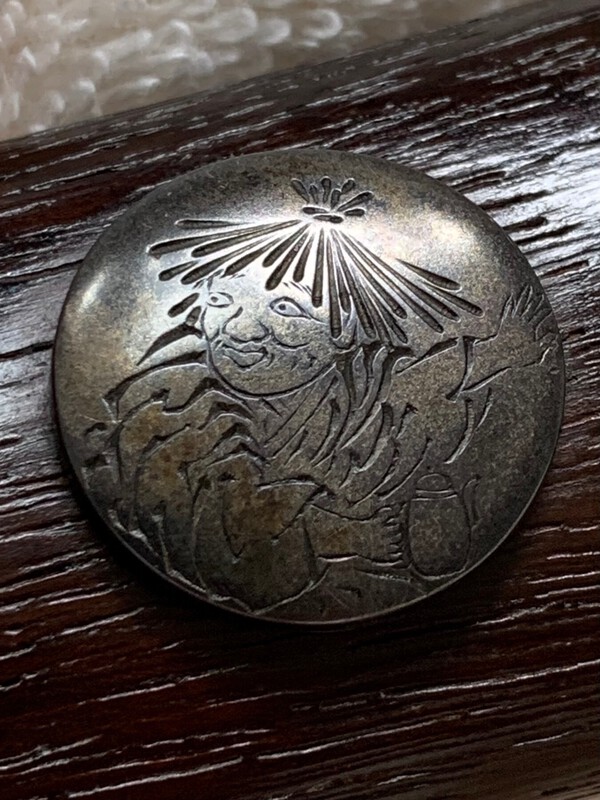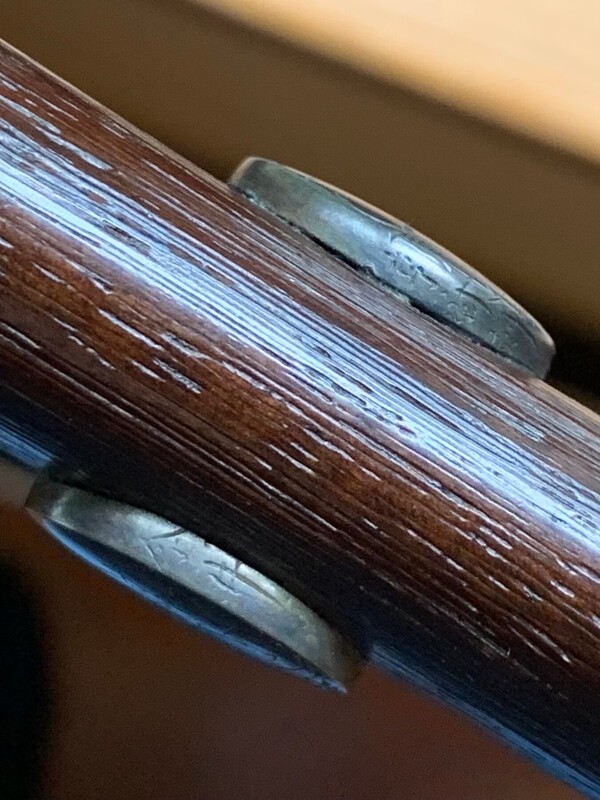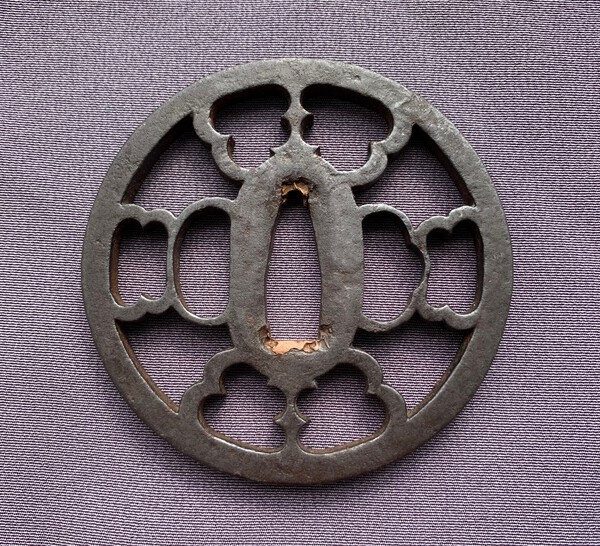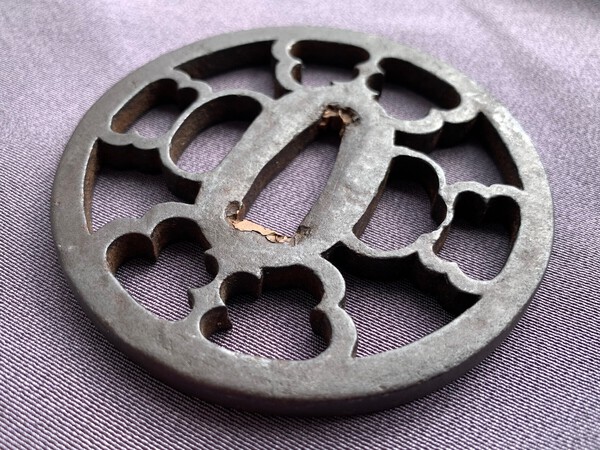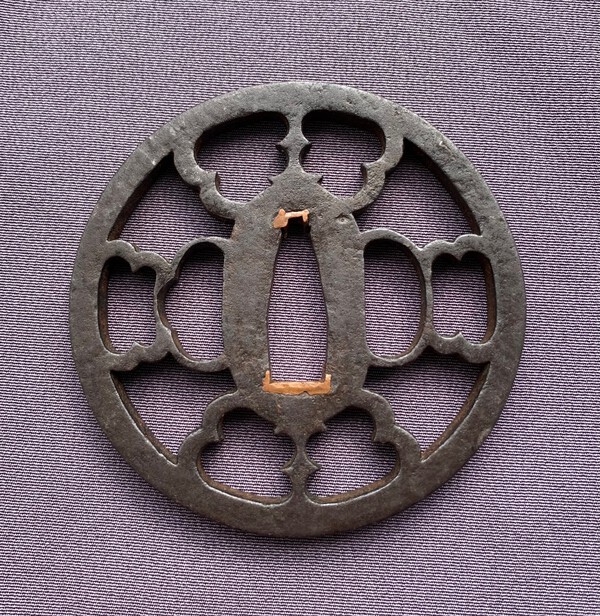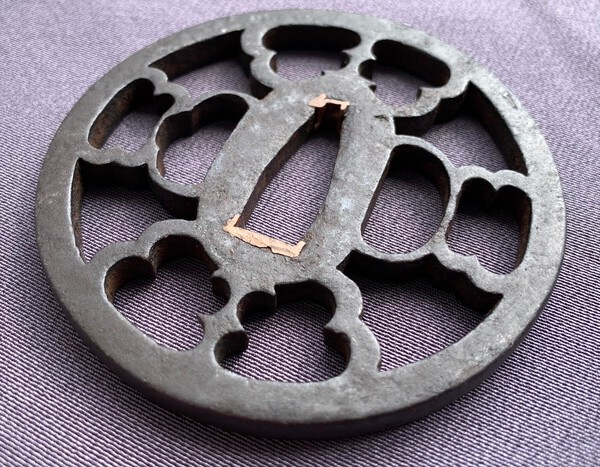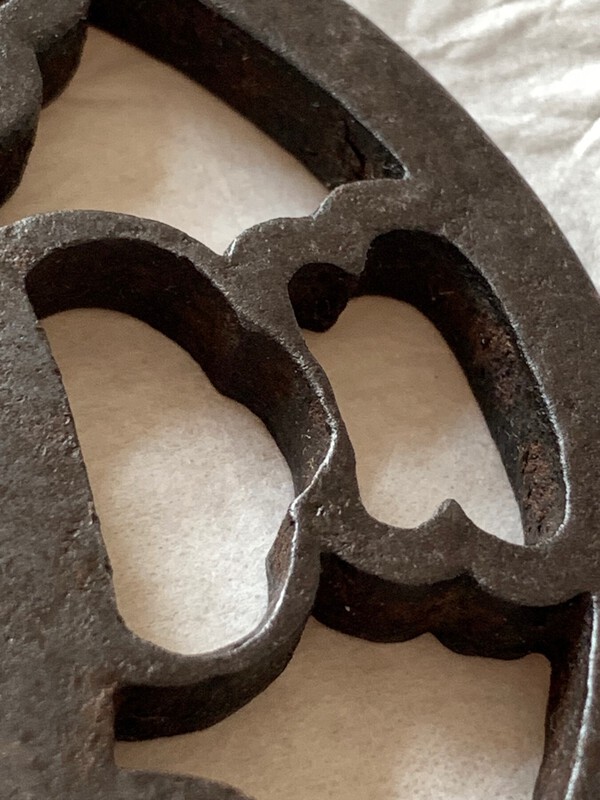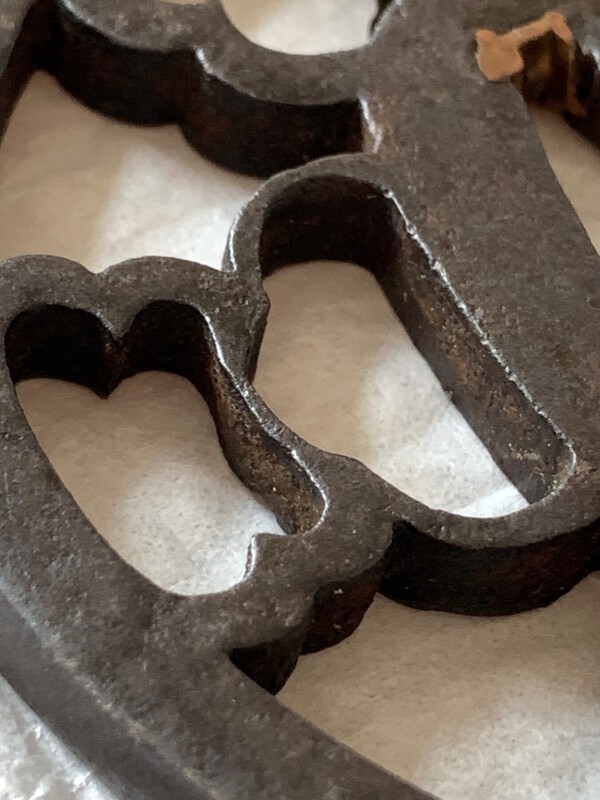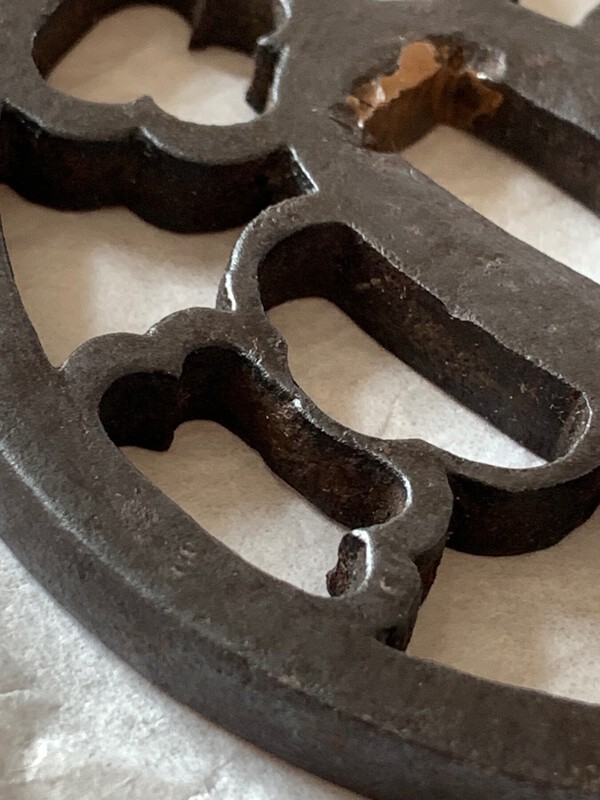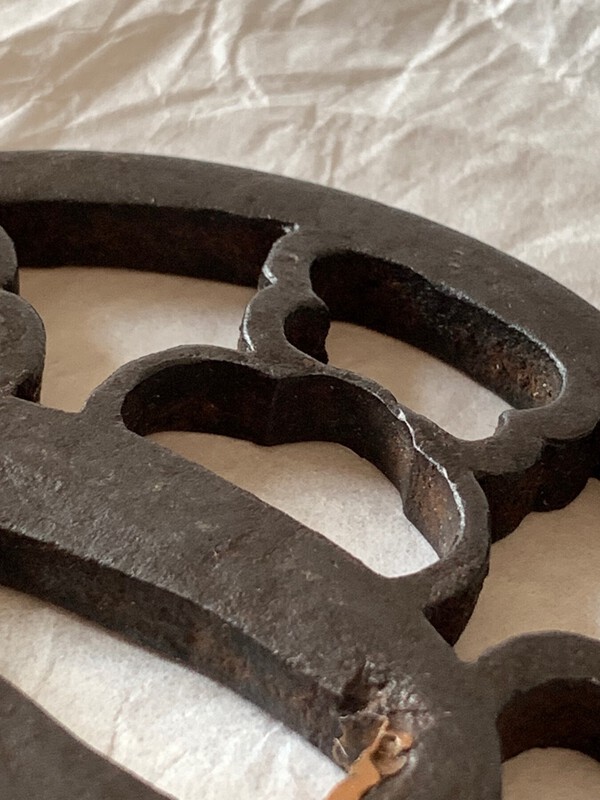
Higo-san
Members-
Posts
707 -
Joined
Everything posted by Higo-san
-
-
Dear all I have always found that fuchi are a nice option for those who want to own a better quality piece of Tosogu at a relatively reasonable price. Now I would like to part with part of my fuchi collection. A tsuba by one of these artists is likely out of (financial) reach for most collectors but I hope that some will enjoy the opportunity to buy a fuchi which has been crafted with the same dedication like a tsuba. And yes: my IPhone camera does only give a mere feeling of the quality of the pieces - but does not do them justice! Number 1): Umebachi Mon in gold on a fine shakudo nanako ground Mei: Shonai Ju Kumagai Yoshinobu Saku (庄内住熊谷義信作) Tenpō Kū Nariharu (天保九成春) - Begin of spring in 1838 A piece which has been created for a daimyo! Wonderful workmanship which equals even the greatest machibori masters. Kumagai Yoshinobu was a famous craftsmen who lived from 1790 until 1867. He was the adopted father of Funada Ikkin and probably one of first teachers before he was accepted as apprentice of Gotō Ichijo and became one of his famous pupils. The piece comes with NTHK Hozon papers in a custom-fitted box. Asking price: EUR 420.00 plus shipping costs Number 2): On a fine nanako ground, a fisherman and three karako musicians can be seen Mei: Yamazaki Ichiga (山崎一賀) Hakogaki by Torigoye Kazutaro: Outer lid: 山崎一賀 - Yamazaki Ichiga 縁頭 - Fuchi Kashira Inner lid: 徭 刃宗 壹寸貳分[?] 昭和四十二年七月吉日 - Showa 42 7th month lucky day (July 1967) 右正作也 - Migi shosaku 在耶 Saro [Kao] = used by Torigoye in the 1960s and while traveling Yamazaki Ichiga studied under the sideline Gotō master Jujō and was famous for carving faces and small figures. Asking price: EUR 350.00 plus shipping costs Number 3) My personal highlight at the end: on a fine shakudo nanako ground three crabs come into life. The kani have been so well carved that they almost seem to be real. The whole fuchi is made from shakudo which is quite rare and further attests to the quality of the piece. Mei: Gotō Mitsumori (後藤光守) Asking price: EUR 500.00 plus shipping costs I have not provided measurements as these should not be used for mounting. But I am happy to provide additional information. Shipping costs are: Germany EUR 6.99 EU EUR 16.99 UK EUR 26.99 Worldwide EUR 46.99 Kind regards Chris
-
SOLD on Catawiki
-
No reserve this time (strange times for tsuba sellers…): https://www.catawiki...ama-period-1573-1603
-
Dear all I am looking for the above mentioned auction catalogue to complete my set (I already have Part I). I have seen the catalogue for sale in the internet but I would prefer to buy from a member here (preferably located in the EU to save taxes and shipping costs). Sale took place in New York on 3/29/05. Kind regards Chris
-
Thank you so much, Moriyama-san! That’s it!
-
Dear all I could need a little help translating a hako-gaki of a missing tsuba. That is what I have figured out so far: 鍔鐵 - Tsuba made from iron 出羽秋田住正阿弥傳七 - Dewa Akita ju Shoami Denshichi (artist who made the tsuba) [][][][之?][え?]虎 - ???? Tora (tiger) As you can see, I have difficulties reading the second line from the right. As I mentioned, the tsuba got lost (all that is left is the hako-gaki) and any help finding it would be much appreciated. BTW, Denshichi was a student of (the) Yasuchika. Man thanks Chris
-
Agree with Piers - certainly, there is no wrong or right to this question. First of all, symbols were chosen as a kamon because they had a specific meaning (long before they were turned into kamon). For example, the ume (plum) is one of the Three Friends of Winter. It symbolizes i.a. steadfastness, perseverance and resilience. Therefore, it is a natural choice as a symbol for a warrior. As a symbol, it is also highly regarded in Confucianism. That being said, an ume mon can always have at least two meanings: a heraldic meaning as a kamon and a symbolic meaning as a reference to the Three Friends of Winter. How can we decide which meaning is the right one in a specific case? That brings me to my second point: the (mis)use of only very few kamon was sanctioned by law during the Edo period. That is true e.g. for the aoi kamon used by the Tokugawa (main) family. That means that basically everyone was allowed to use whichever symbol he/she likes (as long as it was not the Tokugawa or an imperial symbol). However, some kamon are seldomly found on sword mountings. In many cases, these are modifications of very basic kamon and therefore likely have a heraldic meaning. Last but not least, we find pieces which show a whole range of different mon. Hayashi Shigemitsu and Tohachi were famous for such tsuba. I have once owned such a piece which came from the collection of Sasano Masayuki and is depicted in two of his publications. The design compromises different mon which could either be kamon or symbolize different aspects of the Japanese culture. I finally came to the conclusion that designs which combine various mon do neither have a heraldic (like a wedding between members of two important families) nor a symbol meaning. In order to understand my way of thinking, we have to understand the Edo period culture. We have to understand the importance of ceremonies and philosophy. The sword itself becomes a symbol of power. The importance of a sword as a weapon is declining in the Edo period. In other words: a sword had to look good when strolling through the streets of Kyoto. And as we can see products made from silk or lacquer which show all kind of mon and which are meant for decoration only, I believe that the same thing is true for tsuba. The Hayashi family and other tsuba artists created designs which looked powerful on the one hand but on the other hand could be worn on an elegant occasion. Hopyfully, this adds to the discussion. Chris
-
Hi Piers, the NBTHK uses the 小 Kanji which makes sense as it is meant to be translated as small (rather than old). You are correct regarding the Ji-Kanji. But you do not have to add the hiragana for ka and shi after 透. Best, Chris
-
I quite much like your approach. Determining the age of a tsuba is not just guessing or judging by experience. There are some criteria. Let us start with the design. When it comes to sukashi tsuba, there are ko and ji sukashi designs. Ko sukashi designs can be found on tsuba dating back to earliest times. Ji sukashi tsuba became more popular later on and became the predominant design in the Momoyama (maybe even mid-Muromachi) period. The tsuba in question shows elements combining both the ko and ji sukashi style. This can be well seen on the upper half of your ume blossom where the negative image turns into a positive one. That being said (and not taking into account the possibility of a later modification of the design which was also quite common) we can rule out a very early piece. We do either have a transition piece or a later combination of the two styles (which is therefore not a revival in a strict sense). Looking at the somewhat fan(cy) design of the hitsu, I would rule out a transition piece. That means that the tsuba was made in a time when both the ko and ji sukashi style had been fully evolved (Momoyama or maybe a bit earlier). And now we have to decide when it became popular to combine ko and ji sukashi designs and create somewhat fan(cy) hitsu. That finally brings us to the Edo period. Best Chris
-
Tsuba is now at auction: https://www.catawiki...ama-period-1573-1603
-
Thank you so much, Peter! You hit the nail precisely on the head. I did not realize that there was an oil jug depicted on the menuki! Best Chris
-
Dear all I own a pair of menuki mounted on a beautiful tanto koshirae and signed Imai Kyusai Sei (今井 亨斎製) who was also called Nagatake (NBTHK judgement: Horyu which I can very well understand and accept). I am not looking for an authentication of the mei on the menuki but rather am I interested in the story which is shown on the menuki. What can be seen? It seems like a thief wearing a straw hat was caught in the middle of stealing a tea pot on the one side which does not amuse a lord who is ready to draw his sword on the other menuki. Does someone recognize the legend behind this scene? Kind regards Chris
-
Okay - now a last chance for all bargain-lovers: EUR 1,000.00 until the end of the week.
-
I was requested to provide additional pictures of the kogai-hitsu which is original and was not modified at some point.
-
Bump! Final price cut to EUR 1,200.00 plus shipping costs!
-
Got it, Steve! Best Chris
-
Yes it is still available - this tsuba dates from the Momoyama / earliest Edo period!
-
Price cut to EUR 1300.00 plus shipping!
-
Huge price cut to EUR 1500.00!
-
Price drop to EUR 1,700.00 plus shipping - just to remember everone: this piece has been confirmed as an authentic Owari piece by the NBTHK last year!


